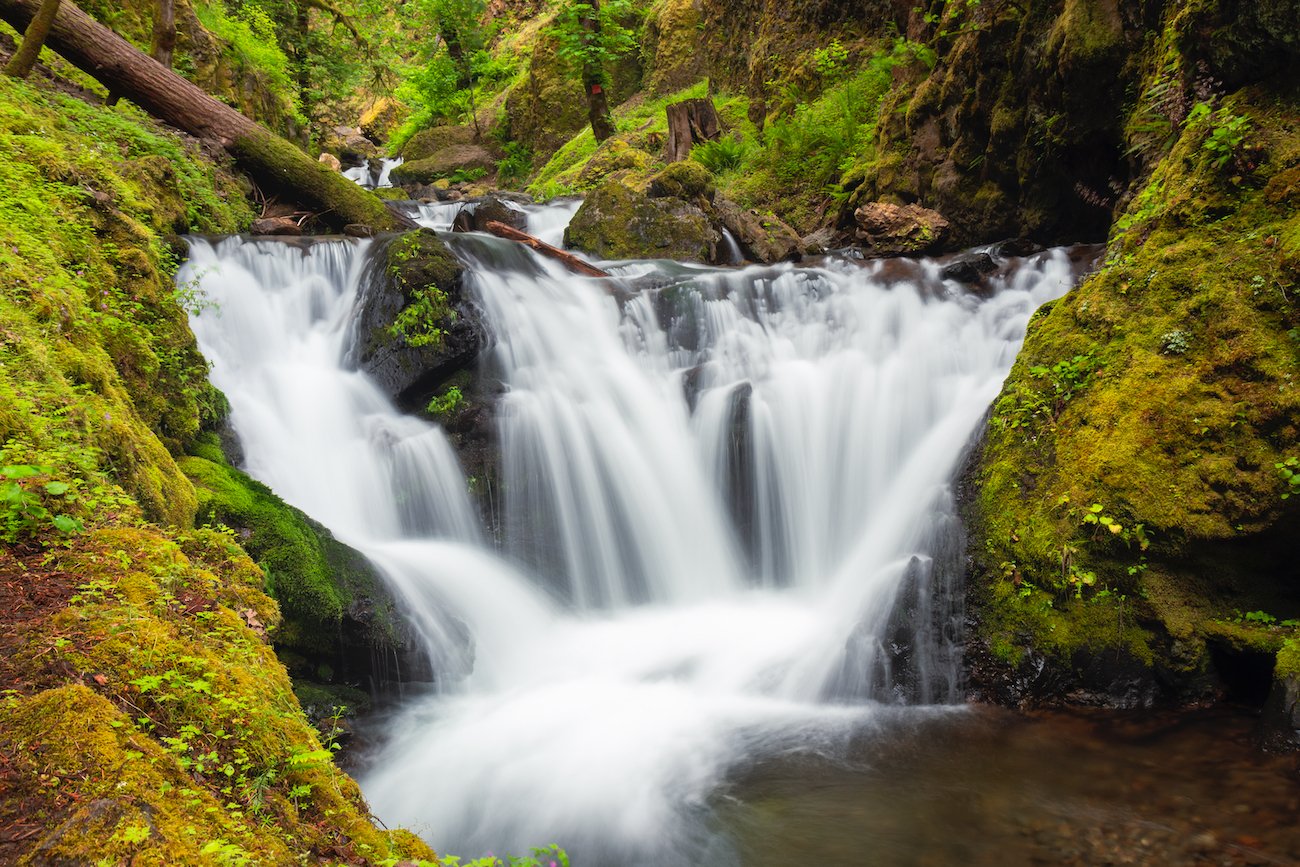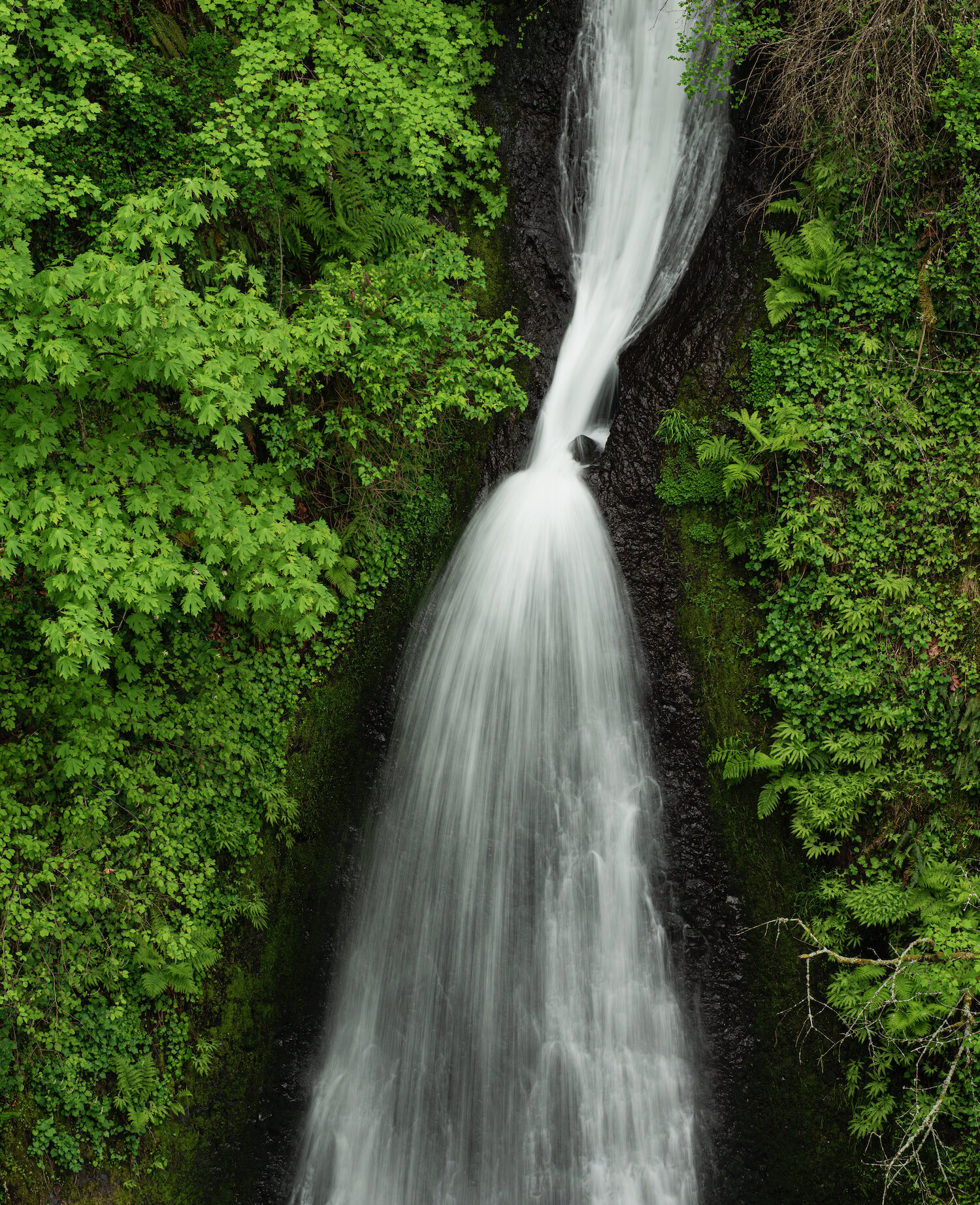Columbia River Gorge national scenic area
The Columbia River Gorge is, no doubt, the waterfall capital of Oregon. Dozens of waterfalls originating from Mount Hood and other mountains to the south descend a series of cascading terraces to reach the mighty Columbia River. Numerous steep valleys and smaller gorges filter the water through scenic environments for which the Gorge is famous. An unfortunate fire in 2017 badly scarred the land and temporarily closed recreation sites, but trails are slowly reopening, and the landscape is now green and thriving.
Upper Bridal Veil Falls
Dry Creek Falls
Latourell Falls
The most famous waterfall in the Gorge is Multnomah Falls, which has two distinct drops separated by its photogenic bridge, but other highlights abound, including Latourell Falls, which falls uninterrupted for 250 feet.
A few of the waterfalls in the Gorge drop in front of truly awe-inspiring amphitheaters, including the basalt rocks of Dry Creek Falls and the mossy terraces of Upper Bridal Veil Falls. Others, like Lancaster Falls and Shepperd's Dell Falls, filter water through narrow openings and fan out near their base.
Emerald Falls
Lancaster Falls
Shepperd's Dell Falls
Bridal Veil Falls
Wahclella Falls
Wiesendanger Falls
Other well-known gems like Wahclella Falls and Dry Creek Falls are accessed through fairly short hikes through some wonderful forested terrain. Those looking to stretch their legs should consider the Wahkeena Falls Loop Trail, a 5-mile hike starting either at Multnomah Falls or Wahkeena Falls that parallels two rivers and passes three distinct waterfalls: Wiesendanger Falls, Ecola Falls, and Fairy Falls. Alternatively, hikers could take the Herman Creek Trail, which has huge waterfalls in its first few miles. The variety of waterfalls in the Columbia River Gorge will satisfy anyone, and its proximity to Portland makes it a popular recreation area.
Cabin Creek Falls
Fairy Falls
Nick Eaton Falls
Camp Creek Falls
silver falls state park
Silver Falls State Park is one of Oregon’s most beloved and historic parks, preserving the waterfalls and forests in the canyon carved by Silver Creek. The park is primarily known for the numerous waterfalls that visitors access by hiking the stunning 8-mile Trail of Ten Falls. As Silver Creek flows downstream, it cascades over a series of cliffs that hikers can walk behind. Some of the most famous falls in the park, like South Falls, North Falls, and Middle North Falls, can be viewed from the front and from behind.
South Falls
Lower South Falls
Unnamed Falls, North Fork Silver Creek
North Falls
Middle North Falls
Not all of the waterfalls in Silver Falls State Park have the same form and flow. Some, like Double Falls, are thin bands of water that drop around 180 feet, while others, like Lower North Falls, only fall 30 feet, but the water spreads evenly over its wide 55-foot face. This diversity makes this park and trail endlessly entertaining for waterfall lovers.
Double Falls
Lower North Falls
mount hood national forest
Of the many waterfalls that originate from the heights of Mount Hood—Oregon’s tallest mountain—two in particular are notable for their size and beauty: Ramona Falls and Tamanawas Falls. Ramona Falls, on the west side of the mountain, is accessed via a 7-mile loop hike and follows the downstream flow of the waterfall through a lovely riverside trail. Tamanawas Falls, on the east side of the mountain, is a shorter 3.5-mile hike that similarly follows the fall’s downstream flow until one reaches the imposing rock face of the fall itself.
Ramona Falls
Tamanawas Falls
Willamette National Forest
For the sake of simplicity, the Willamette National Forest referenced here includes the Santiam Wilderness, Opal Creek, Bull of the Woods, and other small, nearby protected areas. It covers a huge portion of Oregon’s Cascades and is, unsurprisingly, home to a number of the state’s amazing waterfalls.
Abiqua Falls
Shellberg Falls
Downing Creek Falls
Abiqua Falls, for example, accessed through a moderately steep hike down, is a large waterfall that pours over a dramatic, multicolored basalt rock amphitheater. The waterfall itself is gorgeous, but the rock wall is so unique that it would be impressive even without the water flowing through. Another, Shellburg Falls, also contains a stunning rock amphitheater, and its overhang is so exaggerated that hikers are able to walk behind it and view the area from a novel perspective.
Downing Creek Falls, an elegant waterfall off an unassuming pull-off on Highway 22, is a favorite in the region, as water flows from nearly its entire face after a steady rain.
For fans of riverside walks, the Opal Creek Trail east of Salem is a prime destination. It’s known for its distinct deep canyon, rocky walls, and stunning turquoise water. The 7-mile round-trip trail moves upstream beside the creek, providing views downward to numerous waterfalls. The exception is Flume Creek Falls, which flows directly onto the trail and cascades down into the turquoise Opal Creek below.
Flume Creek Falls
Opal Creek
A stunning multitude of cascades is also present in the beautiful teal waters of the McKenzie River, situated in the heart of Willamette National Forest. Similar to Opal Creek, the trail that circumambulates the river provides views toward the roaring waters below as they drop from terrace to terrace. Here, Sahalie Falls and Koosah Falls attract the most attention, but the whole trail is dotted with smaller falls of equal beauty.
Proxy Falls, another major landmark of the area, is also awe-inspiring and packs two falls in one trail. The lower falls consist of a near-vertical waterfall that pushes water over a huge, mossy rock wall. It’s a favorite of many photographers. Upper Proxy Falls is a bit harder to see from its base due to the abundant foliage that surrounds it. There is an unofficial trail that climbs to the right side of the waterfall, accessing the various sections, including the one pictured here.
Lower Proxy Falls
Koosah Falls
Upper Proxy Falls
umpqua national forest
The waterfalls of southern Oregon are less known and visited than those in the Willamette, but their variety makes them essential for any waterfall lover to explore. The best place to begin is Highway 138, which travels from Roseburg, Oregon, to Diamond Lake, near Crater Lake National Park. The section that cuts through the Cascade Range in Umpqua National Forest is, unsurprisingly, the location of many waterfalls. Together, these falls are known as the 'Falls of the North Umpqua River.’
Toketee Falls
Whitehorse Falls
Lemolo Falls
Many of the waterfalls along Highway 138 only require a short hike to access. For example, the first, Toketee Falls, is accessed through a half-mile walk through verdant old-growth forest to an elevated viewpoint. The nearby Watson Falls is the opposite—seen from below by looking up at the enormous semi-circle rock amphitheater that it drops over. The more modest Whitehorse Falls is also right off the road and next to a riverside campground.
Clearwater Falls is farther east on Highway 138 and is not so much one unified waterfall but rather a series of cascades through rocky, mossy terrain. The area around Lemolo Lake is also home to two stunning waterfalls: Lemolo Falls and Warm Springs Falls, both of which drop into scenic canyons and are highly worth the Highway detour.
Clearwater Falls (detail)
Warm Spring Falls
Lake in the woods
One of the prettiest sections of Umpqua National Forest, particularly for waterfall fans, is the Lake in the Woods area. Three waterfall hikes stem from near the lake itself, which is tucked in an idyllic forested location: Yakso Falls, Clover Falls, and Hemlock Falls—each with their own unique charm. Travelers should also consider exploring Wolf Creek Falls to the west for its unique rock slide.
Clover Falls
Yakso Falls
Hemlock Falls
Wolf Creek Falls
National Creek Falls
Umpqua National Forest is absolutely packed with several unique waterfalls located on gravel forest roads both north and south of Highway 138. I highly recommend six in particular: Grotto Falls for its sweeping amphitheater setting, Spirit Falls for its beautiful moss-laden rock wall, Moon Falls for its enormous height, National Creek Falls for its chaotic cascades, and both Upper and Lower Trestle Creek Falls—accessed through a lush 5-mile hike through the forest.
Grotto Falls
Spirit Falls
Upper Trestle Creek Falls
Rogue River-Siskiyou National Forest
One of the more underappreciated and less visited federal lands in Oregon is located in the southwestern portion of the state and is home to the Southern Oregon Coast Range as well as a number of wild and scenic rivers.
As its name implies, the Rogue River–Siskiyou National Forest protects the Rogue River, along with the Illinois River and Coquille River, among others. There aren’t many trails in this national forest, so it’s likely that many beautiful waterfalls along these rivers are beyond the reach of most hikers. Nevertheless, there are a couple of great falls on the Coquille River near Forest Road 33, including Coquille River Falls and Upper Coquille River Falls, and one (Lower East Fork Falls) off Coos Bay Wagon Road. Further north, near Coos Bay, two twin falls—Silver Falls and Golden Falls—are some of the most majestic and powerful in the region. The remote park that houses them is well worth a visit.
Lower East Fork Falls
Coquille River Falls
Upper Coquille River Falls
Golden Falls















































